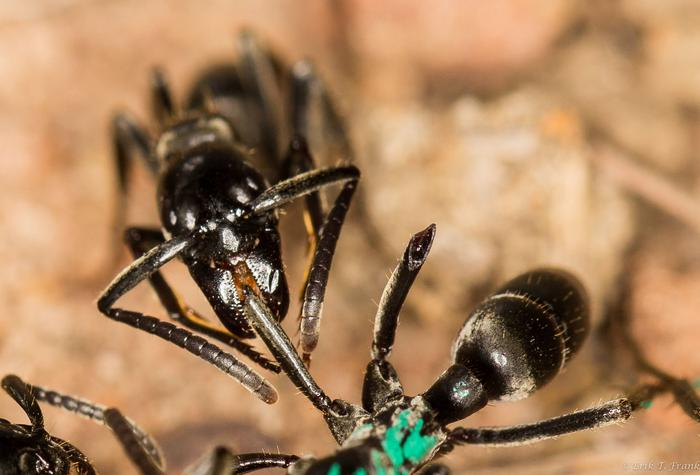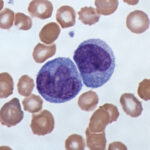Ant-ibiotics: How Ants Treat Infections
Matabele ants of sub-Saharan Africa are the only other known species to recognize infections and be able to use antibiotics for treatment.
By Bryce Larson
The world of ants is a medieval one. Tiny kingdoms in life or death conflict. But one ant species makes use of a technology well beyond the medieval era: antibiotics.
Dr. Erik Frank from the University of Würzburg and Professor Laurent Keller from the University of Lausanne led a study about a particular species of ants capable of identifying infected wounds and producing their own antibiotic to treat the infection.
Matabele ants, or Megaponera analis, live in sub-Saharan Africa. They have a narrowly carnivorous diet consisting almost entirely of termites, an abundant source of protein in the savannahs. These 20-millimeter insects, upon designating a mound to victimize, form a thick band and march into the enemy position hoping to overrun the mound. The termites, however, are far from undefended.
Termite prey of Matabele ants
Termites exist in a strict caste system, each termite playing a role. There is a king and queen, alates (winged termites that leave the nest to start new colonies), workers, and soldiers. The termite soldiers have been in a long arms race with the Matabele. But in the case of the termites, that arms race went largely to their heads. Termite soldiers have heads and mandibles so large that they often cannot feed themselves and rely on workers to bring them meals. Some species of termite soldiers will even use their bulbous heads to plug the entrances to their mound (a tactic called phragmosis), or produce a sticky substance to ensnare invaders. It should come as no surprise then that the Matabele ants raiding these termite mounds face a gruesome fight.
RELATED: Amazonian Frog Uses Mimicry to Ward Off Ants
Ant raiding tactics
For the raid of a termite mound, the ants form a thick column with the largest soldiers at the front and rear before charging into the termite nest. They need to overrun the guards. In this battle, however, the ants suffer their own losses. Approximately 22 percent of the Matabele ants involved in raiding a termite nest will lose at least one limb. Injured Matabele may be carried back home by fellow worker ants. Then it is time for them to start a well-earned recovery.
RELATED: Wood Ants Make Defensive Cocktails Against Microbes
Nursing the wounded ants
Dr. Frank’s research team found that Matabele ants demonstrate a unique ability to recognize and treat infections on wounded ants with an antibiotic.
The research shows that ants returning from raids typically receive a simple cleaning of their wounds by nursing ants back at the nest. Some wounds become infected, oftentimes by the bacterial load within the soil. These infected wounds are additionally treated with an antibiotic secretion from the ant’s metapleural gland. When presented with an infected wound, the nursing ant will undergo a longer process. This process involves first cleaning the wound and taking from their own metapleural gland or the gland of the soldier they are treating. They apply this salve to the wound of the soldier. This process can take upwards of a minute longer than a typical treatment but is effective. The researchers found that infected Matabele that are treated by this process see a 90 percent reduction in mortality.


The Matabele ants aren’t the only ants to possess this metapleural gland. But theirs is uniquely antibiotic. Many other ant species with this gland produce a chemical formula consisting of between 1 and 35 compounds, most of which act simply as acids. These other ants then use this acidic secretion as a home detergent to clean and disinfect their nest, including clearing patches of funguses. The metapleural gland of the Matabele, on the other hand, consists of 112 chemical compounds. The researchers identified at least 6 of these to have antibiotic properties.
RELATED: Be a part of insect research with Citizen science projects featuring insects, spiders and their relatives
The ability of the Matabele to distinguish infected wounds and utilize antibiotic treatments makes them the only other animals other than humans to demonstrate this kind of behavior. The study notes that several mammals lick their wounds to apply antiseptic saliva. However, scientists don’t know how effective this behavior is, and it occurs regardless of whether the wound is infected. The Matabele, however, know an infection when they see, or smell, one and have the means to treat it.


These insects not only fight their infections in a similar manner to modern human medical techniques; it turns out that they are fighting the very same infection. The primary bacteria that infects the wounds of Matabele ants, Pseudomonas aeruginosa, is the leading source of human infections as well. For this reason, the researchers hope that learning more about the ant’s battle against infections might help us in our own fight against the bacteria.
This study was published in the peer-reviewed journal Nature Communications.
Reference
Frank, E. T., Kesner, L., Liberti, J., Helleu, Q., LeBoeuf, A. C., Dascalu, A., Sponsler, D. B., Azuma, F., Economo, E. P., Waridel, P., Engel, P., Schmitt, T., & Keller, L. (2023). Targeted treatment of injured nestmates with antimicrobial compounds in an ant society. Nature Communications, 14, 8446. https://doi.org/10.1038/s41467-023-43885-w
Photos courtesy of Dr. Erik Frank, JMU Biocenter, [email protected], Wound Care in Matabele Ants [VIDEO] | EurekAlert! Science News Releases
About the Author
Bryce Larson is a graduate of the University of Washington who studied history and minored in experimental physics. Follow Bryce on Instagram @brycel717.




